Canada and America are filled with many wonderful birds with yellow wings – in fact, there are 12 birds that you can spot. Have you spotted a bird with yellow wings that you’re looking to identify? Look no further than this article.
This article will list all 12 birds and help birdwatchers find and identify all birds of North America that have yellow wings with both pictures and calls.
1. Yellow Warbler
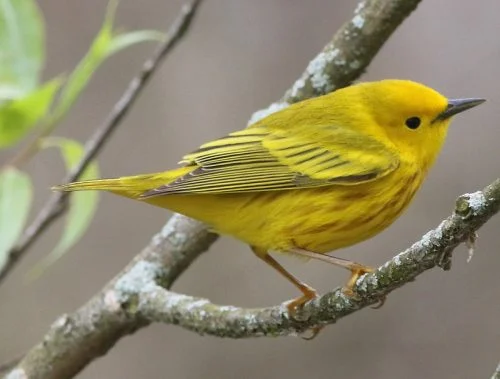
The yellow warbler is a New World warbler species. It is a little bird with dazzling yellow coloration. The tops of their bodies are slightly greenish, and their tails are a greenish yellow.
They have smooth, unblemished skin on their heads and faces. Males have crimson lines running down their chests and stomachs. While females have their male counterparts’ golden coloring, their hue isn’t quite as vivid, and they don’t have any crimson markings.
During the winter, they switch to a diet heavy on berries and other small, luscious fruits, but they spend the rest of the year feasting on insects and other invertebrates.
There is hardly any part of the Americas where you won’t find a breeding pair of yellow warblers. Their breeding area extends from southern California to the Amazon region, Bolivia, and Peru; in the winter they migrate south to spend the winter there.
Mangrove forests, marshes, tropical moist forests, and shrubland are all common places to see these birds throughout the winter.
To learn more about the Yellow Warbler you can visit: https://www.audubon.org/field-guide/bird/yellow-warbler
2. Common Yellowthroat
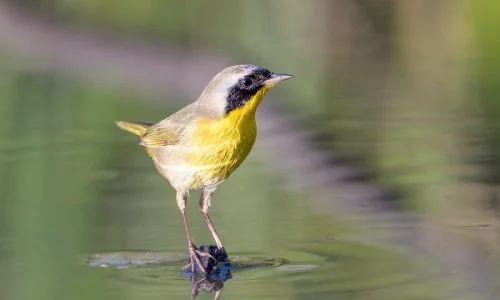
Common yellowthroats are small songbirds. Adult males have a spiky black face mask and are olive on top and brilliant yellow on the bottom. On the other hand, adult females are a solid olive brown throughout, with a contrasting brilliant yellow throat and undertail. In addition, signs of the full mask can be seen even in young men.
Common yellowthroats, which eat exclusively insects, are considered strictly insectivorous.
Wasps, grasshoppers, dragonflies, damselflies, moths, flies, ants, aphids, leafhoppers, mayflies, beetles, grubs, bees, cankerworms, and small spiders are the most prevalent insects.
They are so protective of their nests that common yellowthroats would never fly straight to them, instead landing within walking distance and making the final approach on foot.
The spring and summer are prime times to spot common yellowthroat in North America.
From August through October, these birds make their annual migration south to spend the winter. Swamps, wet thickets, marshes, and margins are typical environments for these animals.
To learn more about the Common Yellowthroat you can visit: https://www.audubon.org/field-guide/bird/common-yellowthroat
3. Wilson’s Warbler
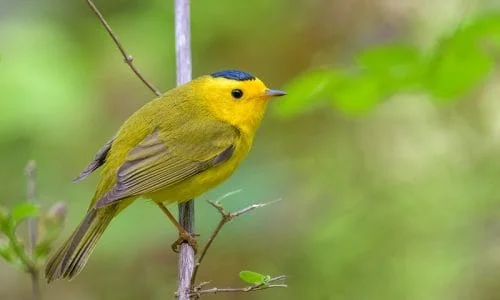
A small and active warbler was seen hopping from branch to branch in bushes and trees while flipping its longish tail. It has round wings and a long, slender tail. A black hat is a distinguishing trait of both genders; however, young females lack it.
Wilson’s warblers have thin, tiny bills because they are one of the smallest species of warblers.
Wilson’s warblers are omnivores, meaning they eat a wide variety of foods, including fruits, nuts, seeds, and insects. These birds mostly feed on beetles, caterpillars, bees, wasps, aphids, and small spiders.
Wilson’s warblers can be found in the southern United States, particularly along the coasts of California and the Gulf of Mexico, as well as in Mexico and Panama. The thickets along wooded streams, low bushes, wet tangles, willows, and alders are popular places where these species can be found. It is the only migrant warbler regularly found in tropical high plains
To learn more about Wilson’s Warbler you can visit: https://www.audubon.org/field-guide/bird/wilsons-warbler
4. Nashville Warbler
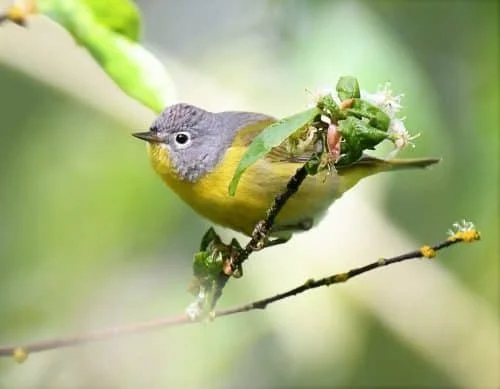
The Nashville Warbler is a boisterous yellow singer that looks like it has big eyes because of its white eyering, which stands out against its gray hood in a big way.
Their wings are yellow, and their bodies are light gray with white eye rings. Both sexes are very similar; however, the adult male stands out thanks to his rufous crown. It’s challenging for both males and females to spot the hue change under natural conditions.
Insects and other arthropods make up nearly all of the Nashville Warbler’s diet year-round. Suet cakes are a popular food source for birds in the south throughout the winter. Flying insects, grasshoppers, leafhoppers, caterpillars, beetles, and spruce budworms are all examples of insects that these creatures eat.
The best time to see Nashville Warblers in most of North America is during their annual spring and fall migrations. Keep an eye out for them in brushy or semiopen habitats at medium heights; chickadees, titmice, and kinglets, among other migrants, are commonly seen in large groups.
To learn more about the Nashville Warbler you can visit: https://www.audubon.org/field-guide/bird/nashville-warbler
5. Hooded Warbler
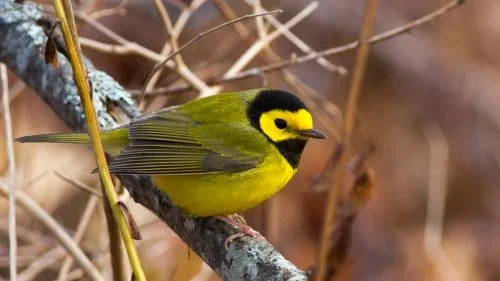
The hooded warbler is a New World warbler. It flits through shrubby understories in eastern forests, flicking its tail to show off its white tail feathers.
The attention-grabbing features of this male are his bright yellow cheeks and forehead, which are framed by a black hood and throat.
They feed on a wide variety of insects, including caterpillars, moths, grasshoppers, beetles, flies, and many others; they also eat many small spiders.
Hooded Warblers use a method of hunting known as “hawking,” in which they pluck insects and spiders off of leaves or the ground and then fly up to swoop down and seize them.
Its breeding range includes much of the eastern United States and southern Canada (Ontario). It’s a migratory species that spends the colder months in Central America and the West Indies.
The hooded warbler is an extremely unusual visitor to western Europe. This warbler generally hangs out in the understory of forests, which makes it easier to find than those canopy-loving warblers.
To learn more about the Hooded Warbler you can visit: https://www.audubon.org/field-guide/bird/hooded-warbler
6. Summer Tanager (Female)
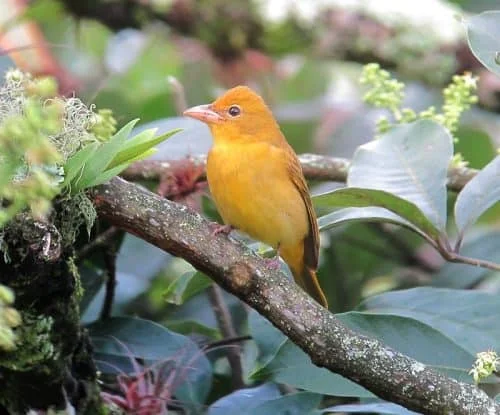
The summer tanager is the most common tanager in the United States continental flyway, and its vivid red plumage is fitting for a bird with the same name. The wings, head, and tail of a female summer tanager are all solid, and bright yellow.
The summer tanager’s diet consists primarily of insects like moths, spiders, caterpillars, beetles, and other bugs.
Even stinging insects like wasps and hornets are fair game, though the stinger is removed before consumption. After catching the prey, The Summer Tanager flies to a nearby perch, where it drops the prey and repeatedly bangs it until it dies.
The stingers and other non-edible sections of the animal are removed in this process.
The southern United States, including Iowa, is their nesting ground. They prefer open woodland regions, especially those with oaks. These birds go all the way to northern South America via Mexico and Central America. Rarely seen in western Europe, this tanager is a true rarity.
To learn more about the Summer Tanager you can visit: https://www.audubon.org/field-guide/bird/summer-tanager
7. MacGillivray’s Warbler
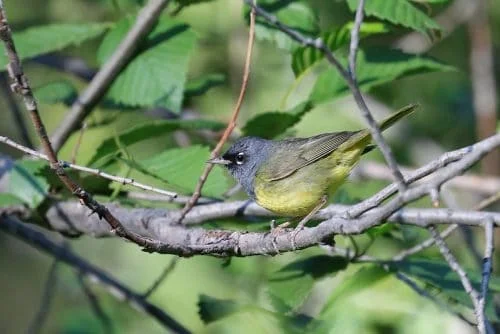
MacGillivray’s warbler is a species of New World warbler. The head of a MacGillivray’s Warbler is bluish-purple, whereas the rest of the bird is olive and yellow. Both the Connecticut Warbler and the Mourning Warbler look similar to it.
These two bird species are visually similar due to their shared coloring. The MacGillivray’s Warbler has partial eyering rather than full eyering or no eyering at all.
You can find MacGillivray’s Warbler nests anywhere from the coast to the mountains, and they can even reach an altitude of 10,000 feet or more.
Their diet consists primarily of insects.
Though its specific diet is mostly unknown, we know that it primarily consumes insects. Click beetles, dung beetles, alfalfa weevils, flea beetles, caterpillars, and other insects are among the foods they have been known to consume.
usually found breeding in the western North American mountains and spending the winter in the southern United States, Central America, or Mexico. It’s similar to the Mourning Warbler, although the ranges don’t overlap much.
To learn more about the MacGillivray’s Warbler you can visit: https://www.audubon.org/field-guide/bird/macgillivrays-warbler
8. Golden-winged Warbler
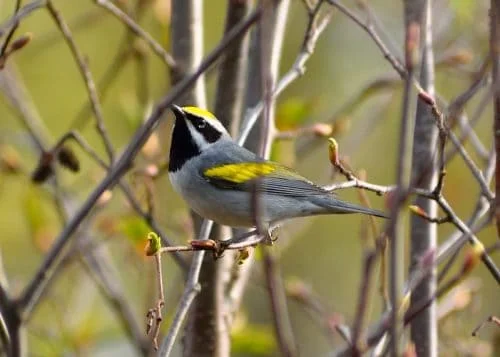
The Golden-winged Warbler is a strikingly characterized species of warbler. The head and wings of a warbler are a brilliant golden color, and the rest of the bird is a slender, silvery gray.
Golden-winged Warblers typically begin reproducing at the age of one and can do so for up to nine years. The female will lay anywhere from two to six eggs in a nest she and her partner have constructed on the ground.
During nesting season, these warblers eat nothing but insects, specifically caterpillars, moths, and other winged insects, as well as spiders.
The areas where the warblers spend the winter have a similar diet.
It is common to see Golden-winged Warblers in the northeastern United States, southern Saskatchewan, Manitoba, Ontario, and Quebec. These birds breed in the middle and eastern parts of the province, from the southern end of Georgian Bay and Lake Ontario to the northern end of the province.
Aside from the Lake of the Woods region in Ontario, golden-winged warblers have been spotted in the Long Point region of Lake Erie.
To learn more about the Golden-winged Warbler you can visit: https://www.audubon.org/field-guide/bird/golden-winged-warbler
9. Lawrence’s Goldfinch
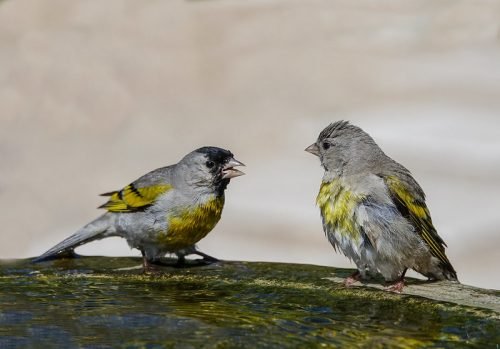
Lawrence’s goldfinch is a small songbird. It’s about 4.75 inches long, weighs around 0.4 ounces, and has less yellow in its plumage than the American goldfinch but more than the lesser goldfinch.
All grown-up individuals of both sexes share a similar gray plumage and a short, pinkish to grayish flesh-colored beak compared to other goldfinches. Yellow can be seen on the rumps and breasts of these birds, as well as the edges of the flight feathers and the wing bars.
For the most part, Lawrence’s goldfinch eats the seeds of shrubs and forbs. It feeds on the seeds of annual plants during the breeding season, with the common fiddleneck being its clear favorite. If you’re looking for Lawrence’s goldfinch, you should be familiar with this plant.
They travel across the Southwest, appearing in the southern sections of Arizona, New Mexico, and possibly West Texas. There is no evidence that Lawrence’s Goldfinches are particularly faithful to certain breeding locations, as huge numbers of the species can be seen in a given area one year and then disappear the next.
To learn more about the Lawrence’s Goldfinch you can visit: https://www.audubon.org/field-guide/bird/lawrences-goldfinch
10. Palm Warbler
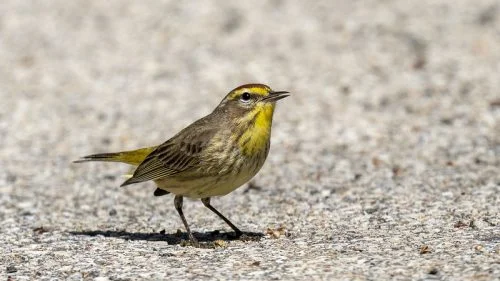
Small and melodious, the palm warbler is a member of the New World warbler family. known for constantly bobbing its tail. Unlike most other warblers, it frequently forages on the ground.
During the breeding season, the bird’s cap will turn a rosy color. Look for a yellow undertail covert, a pale eyebrow, and a dark line through the eye in the fall and winter.
Beetles, flies, and caterpillars are among the things that the Palm Warbler prefers to munch on. Seeds and berries, including bayberry, sea grape, and hawthorn, are also a staple throughout the colder months.
Most of the insects they eat come from the ground or low plants, although they also catch a few in flight.
In North America, its native habitat is the cold, dark boreal forest.
This species has a breeding range that spans the northern United States and Canada. Another category for this species is that of a neotropical migrant. On the East Coast, this species spends the winter from southern Delaware to Florida, and from the Gulf Coast to southern Texas.
To learn more about the Palm Warbler you can visit: https://www.audubon.org/field-guide/bird/palm-warbler
11. Yellow-green Vireo
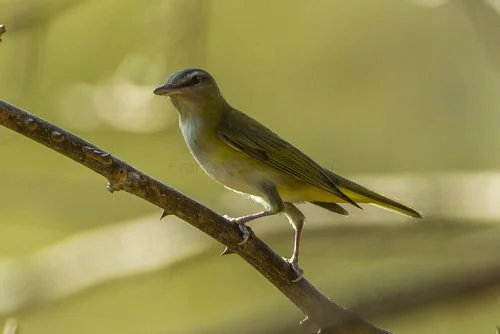
A little bird native to North America, the yellow-green vireo is a member of the passerine family. Adult yellow-green vireos measure 14–14.7 cm in length and weigh 18.5 g. The underside is white, and the breast sides and flanks are a bright yellow.
Young birds have less vibrant colors and appearance; they have brown eyes, a brownish back, and less yellow on their bellies.
A yellow-green vireo’s diet consists primarily of insects it finds in tree leaves, especially caterpillars and beetles. Mistletoe berries are one of the little fruits they enjoy.
Its breeding area extends from central Panama south to southern Texas, across the western and eastern mountain ranges of northern Mexico.
During the winter, it travels south to warmer climates, spending the winter in the western Amazon basin and the northern and eastern Andes. This vireo can be found anywhere from sea level to 1500 meters above sea level in the upper and middle levels of light woods, along forest borders, and in gardens.
learn more about the Yellow-green Vireo you can visit: https://www.audubon.org/field-guide/bird/yellow-green-vireo
12. Evening Grosbeak
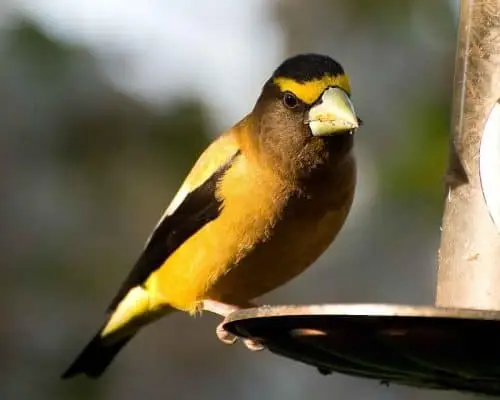
The evening grosbeak is a member of the finch family, Fringillidae. Due to his huge bill and powerful eyebrow stripe, the male yellow-bodied, dusky-headed bird gives the impression of authority.
Females are less boldly marked than males, having soft gray plumage accented by golden spots. The wingspan of an evening grosbeak is between 30 and 36 centimeters, while its body length is between 16 and 22 centimeters.
Sunflower seeds are one of their favorite foods, but they also enjoy eating the seeds, berries, and buds of various trees and shrubs, notably maples. Due to their huge size and tendency to fly in big groups, these birds prefer to feed from platform feeders rather than tube feeders.
You’ll need to travel to the north of North America or the western mountains in the summer to see the Evening Grosbeak, which spends its time in the woods nesting in conifers.
To learn more about the Evening Grosbeak you can visit: https://www.audubon.org/field-guide/bird/evening-grosbeak
